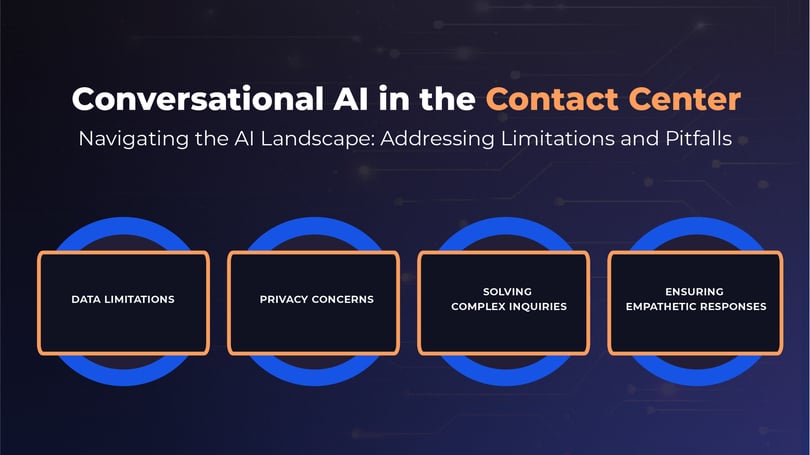When a customer contacts your business, what’s their first impression? Are they met by long wait times and low-performing agents? Or is the opposite true? With the American Customer Satisfaction Index making its largest decline in 28 years in 2022 — falling from 77 in 2018 to 73.1 in 2022 — dissatisfaction and frequent complaints from customers are rising. As organizations are ramping up their digital transformation strategies to meet the immediate and personalized experiences required by today’s customers, it’s no surprise Conversational AI is emerging as the fastest-growing segment within the contact center space.
Conversational AI is a type of artificial intelligence trained on large amounts of data to create human-like experiences through text or speech. It operates using Natural Language Processing (NLP) and machine learning algorithms to drive automated personalization. When integrated with your customer engagement platforms, such as ServiceNow or SAP, the AI can perform repetitive and mundane tasks — such as answering password reset requests or ticket status updates — making it possible to deliver outstanding service to an increased number of customers, without the need for additional agent headcount. It can further assist supervisors with AI Coaching and sentiment analysis to generate intelligent insights and reporting at scale, ultimately creating high-performing agents and improving the customer experience (CX).
Nevertheless — while AI can bring endless scalability, the cost benefits of automation, catered agent coaching, and intelligent insights, it’s crucial to evaluate its potential limitations. How do you know if the benefits outweigh the potential risks? Why should you consider using AI in your contact center? What are the best approaches to implementing AI? In this guide to Conversational AI, we’ll cover if AI is right for your organization, its potential pitfalls, and how to gain the most benefit from it.
|
Part 1: |
How to Know if Conversational AI is Right for Your Organization |
|
Part 2: |
Potential AI Limitations and Pitfalls |
|
Part 3: |
Benefits of Employing Conversational AI in the Contact Center |
How to Know if Conversational AI is Right for Your Organization
Conversational AI offers a unique opportunity to personalize your contact center by enhancing engagements across channels (such as voice and SMS). Imagine if your agents could focus on the most complex tasks while AI seamlessly handles repetitive, everyday requests — such as password resets, case status updates, order returns & refunds, or opening new inquiries. The results? Your organization can improve operational efficiency, effortlessly driving humanized customer interactions for an increased number of customers without the need for additional agents. In fact, Gartner predicts an $80 billion reduction in contact center labor costs by 2026, thanks to Conversational AI eventually addressing many of the mundane tasks live agents handle today. Additionally, AI can help contact center supervisors and administrators automate the often arduous task of creating reports — instead providing intelligent AI-powered analytics, insights, and coaching to drive higher-performing agents while improving customer experiences. Yet, the question still stands — is Conversational AI right for your organization? And, if it is, how can you ensure you reap the greatest benefits from it?
Exploring the Right Fit: 5 Key Questions
To help you assess if AI is right for your organization, we’ve put together a list of five crucial questions to ask yourself during the early stages of your digital transformation journey. If you answer yes to one or more of these questions, chances are your organization would benefit from incorporating artificial intelligence into your contact center initiatives.
-
Is your organization seeking alternative strategies to increase operational efficiency without increasing agent headcount?
-
Are your agents spending considerable time answering common requests (password resets, case status updates, etc.), potentially limiting their ability to answer complex inquiries and increasing call wait times?
-
Are your supervisors investing considerable time manually auditing a limited sample of agent-to-customer interactions for training and performance evaluations?
-
Are your agents “swivel-chairing” between your contact center solution, CRM platform, and additional systems?
-
Is your organization looking to better understand customer sentiment and responses, hoping to gain better knowledge of customer intent while also improving agent performance?

Potential AI Limitations and Pitfalls
Let's address the elephant in the room. AI in customer service does have its limitations. As explained by Aragon Research, “the major challenges in AI often revolve around information quality and integrity, ethics, change management, security, and governance.” In this section, we’ll cover potential pitfalls to consider when making AI a part of your digital transformation strategy.
Data Limitations
Conversational AI is only as smart as the data it has access to. Does the data pull from high-quality sources? If not, the AI’s responses risk being inaccurate or unreliable. Bern Elliot, Vice President Analyst at Gartner, explains: “Customer service and support leaders seeking to use AI to improve digital and self-service customer service should ensure they have sufficient, accurate, and relevant data to support customer service insights and predictions use cases.” If, for example, a customer is speaking to your AI-driven self-service for an update on their ticket status, the virtual assistant can only provide them with the correct information as long as it's accessible in your system of record. What about the back-end process? Conversational AI gathers insights on agent performance by automatically transcribing and performing sentimental analysis for 100% of customer interactions. Thanks to these insights, AI Coaching and personalized performance plans can seamlessly be delivered to the agent. However, to deliver the results you’re looking for, the AI must be programmed to understand what type of training an agent needs to perform better. In other words, to pinpoint areas of improvement, the AI first needs to be fed quality data on how to train a high-performing agent.
Privacy Concerns
Enhancing your customer experience with AI requires access to your system of record. Why? Personalized customer engagements cannot be created if the AI doesn’t have insight into who your customers are. Sharing your data with yet another platform is a reasonable concern, but the risks can be effectively reduced by taking data-sharing restrictions into account. It’s crucial to choose an AI solution with the compliance certifications required for your industry, effectively addressing privacy concerns through encryption and data retention controls. By keeping sensitive information securely stored and de-identifying details such as bank account or credit card information, customer information is kept safe. To put it simply, the Conversational AI should only collect the information needed to match an incoming customer inquiry with your system of record and intelligently answer the customer’s request — keeping all other information securely stored in your CRM.
Solving Complex Inquiries
Enhancing your self-service with intelligent virtual agents will drive personalized experiences. Conversational AI can understand who the customer is and their reason for calling, even before the conversation begins. By analyzing past interactions and preferences, simple questions about password reset and ticket status updates can be easily and rapidly answered. However, AI can only take you that far. While resetting a password is an easy task for the virtual agent, a more complex issue, such as the malfunctioning of a smart TV, could be too complicated for the AI to answer. In today’s contact center, the agent is still the most versatile form of customer service available. While Conversational AI could initiate the support, the expertise of human agents is required to diagnose and solve complex issues — such as the smart TV mentioned above. In short, while AI-driven self-service can limit the number of agents needed by answering simple and repetitive requests, you cannot fully replace your agents with artificial intelligence. To optimize your contact center, you still need both.
Ensuring Empathetic Responses
While limited to the data available, intelligent virtual agents don’t have the same emotional understanding as human beings. Consequently, it needs to be trained to understand how humans react to effectively ensure fairness, transparency, and accountability in its decision-making. As Karen Hao mentions in the MIT Technology Review, unrepresentative training data will prompt AI systems to identify and emulate unrepresentative problems. Imagine a scenario where a customer inquires about their bank account being hacked. The response, “I’m sorry your bank account got hacked. Your account total is ($50). Is there anything else I can help with today?” will most likely generate frustration. On the other hand, an answer such as “I’m sorry your bank account got hacked. I will open a new case and freeze further transactions. An agent will contact you for details.” is most likely a response your customer will be satisfied with. The AI-powered voicebot will not understand what emotions its response might generate — it simply uses the data stored in your database. It’s, therefore, crucial to ensure you’re using a high-quality AI solution, efficiently processing the information needed to deliver carefully crafted responses to enhance the customer experience.

Benefits of Employing Conversational AI in the Contact Center
Ready to embrace the benefits of Conversational AI? For many leading organizations, the benefits of AI outweigh its limitations. With capabilities such as intelligent virtual assistants for customer support, predictive analytics, process automation functionalities, sentiment analysis, and voice & speech recognition, AI’s potential to deliver outstanding customer experiences is — in today’s market — unmatched. In this section, we’ll dive into some common benefits your organization can expect to gain if adding AI capabilities to your contact center.
Decrease Wait Times and Improve Call-to-Resolution Times
Conversational AI, when developed with Natural Language Processing (NLP), leverages Natural Language Understanding (NLU) to help diagnose customer intent more quickly. These technical components of Conversational AI make it possible to understand and analyze a broad range of accents, dialects, and languages to deliver human-like responses to each customer in real-time. As explained by Aragon Research, “Intelligent automation enables organizations to deliver faster, more personalized, and error-free services to customers.” Here’s an example: A customer calls your organization to get information regarding one of your products that’s currently out of stock. They’ve previously filled out a form on your website requesting an SMS once the item is available. With an intelligent self-service center, the virtual agent can verify the caller’s identity based on their phone number (or other verification code) and identify their reason for calling based on the historical information accessible in your system of record. Instead of “press 1 for English, press 2 for Spanish”, self-service powered with Conversational AI cuts straight to the chase. The intelligent virtual agent can ask, “Is the reason for your call in regards to your request for a restocking update?” and it will seamlessly understand a response such as “Yes, I need this product by tomorrow.” Thanks to NLU, it can not only detect the reason for calling but also gather additional information such as quantity needed, shipping address, and place the order for the customer. If requested, the virtual agent can transfer the call to a live agent.
Improve Experiences with Human-AI Collaboration
Your customers want to feel like you know them and understand their specific needs and wants. Recent research by CCW Digital confirms that “More than 90% of customers say they are more likely to support brands that deliver simple, convenient experiences.” With Conversational AI — including historical customer interaction data and real-time sentiment analysis — your agents can effortlessly improve engagement to deliver seamless experiences. How exactly does this work? Conversational AI can assist agents with recommended responses and suggested resources to support the agent while a call is taking place. For instance, if a customer calls your organization regarding a delayed or lost order, sentiment analysis within AI can detect and capture the customer’s emotional reactions throughout the interaction. If the customer is showing emotions such as frustration and anger, the AI can suggest certain responses for the agent — and supporting resources, promo codes, and discounts to ensure increased customer satisfaction. But it doesn’t end here! The AI can also track and score an agent's performance (more about this in the next section), providing valuable insights into improving the service to optimize the customer experience.
Automate Training and Performance Reviews
According to a recent survey conducted by CCW Digital, 75% of leaders state that receiving a full-picture view of agent performance is a major productivity challenge, while 68% agree relevant training and guidance is an issue. With Conversational AI in the contact center, your organization gains access to automated real-time call transcripts, post-call summarization, and AI-powered speech analytics. This provides your supervisors with a complete view of agent performance, making data from 100% of all customer interactions available. With AI-powered sentiment analysis, the customers’ emotional responses throughout every interaction are provided. This empowers your supervisors with the insights they need to effortlessly create personalized performance plans and AI Coaching opportunities to increase agent performance — ultimately improving the customer experience. Furthermore, predictive analytics make it possible to take action in real-time by anticipating customer needs or issues before they arise, leading to more proactive customer service. Your supervisors can, for example, step in to assist an agent if an interaction is going in the wrong direction.
Enhance Performance with Streamlined, Real-Time Insights
To get the most out of AI, integrating your contact center capabilities with your CRM platform makes it even more powerful. When the AI has access to all important customer data, it can identify and resolve customer issues before the call has even started, resulting in an increased number of inquiries being solved without agent involvement. CCW Digital mentions that “AI is famous for its ability to process and interpret data at scale; advanced analytics solutions will help brands capitalize on this opportunity by capturing a broader range of data from all phases of the journey. AI solutions can then populate – and draw from – advanced CRM and CDP solutions, leading to more accurate customer records and more personalized customer interactions.” Additionally, it can push insights and reports to the CRM system, making it possible for your organization to view all information through a single-pane-of-glass. Using AI for data analysis can greatly improve the accuracy of your reporting. If, for example, the AI tool is natively integrated with ServiceNow, data such as call transcription and summaries, sentimental analysis, and more are pushed directly to your ServiceNow instance. This empowers your organization to keep track of all data in one place, gain insights into your queues, analyze wait times with historical information, and create triggers for events where the data is performing differently than expected. With enhanced dashboard views and streamlined insights, data-driven performance enhancements can be made instantly. The AI can also feed into other AI systems, such as the ServiceNow GenAI engine to additionally enhance and improve performance.
Increase Efficiency and Boost Business ROI
With Conversational AI taking over mundane and time-consuming tasks, your team will have more time to focus on what truly matters. Instead of agents spending valuable time responding to ticket status updates or supervisors auditing an excessive number of calls, AI will take care of this. As explained by Aragon Research, “Intelligent automation helps reduce labor costs associated with repetitive and mundane tasks. It minimizes human errors and lowers the need for manual intervention, leading to significant cost savings over time”. That said, Conversational AI eliminates the need for additional workforce — and the costs associated with it. With real-time insights and AI-driven recommendations, your business can make smarter decisions based on 100% of customer interaction data, effortlessly driving smarter decisions to optimize efficiency and ROI.
Conversational AI Conclusions
As we wrap up our guide to Conversational AI, it’s clear that the integration of AI in the contact center is a game-changer for any organization looking to gain a competitive edge. While it does have its limitations, when used in the right way — such as integrated with your CRM to natively enhance your system of record —- it’s proven to transform customer and employee experiences. With automated workflows and triggers, your team can effortlessly increase performance. Not only does it provide your team with the automated insights, data, and recommendations needed to create outstanding customer experiences, but it also increases your ROI by managing mundane tasks and eliminating the need to scale your seat count.
We encourage you to bookmark this blog as your go-to Conversational AI guide. We also invite you to meet with one of our 3CLogic experts and to visit www.3CLogic.com for additional valuable information.




